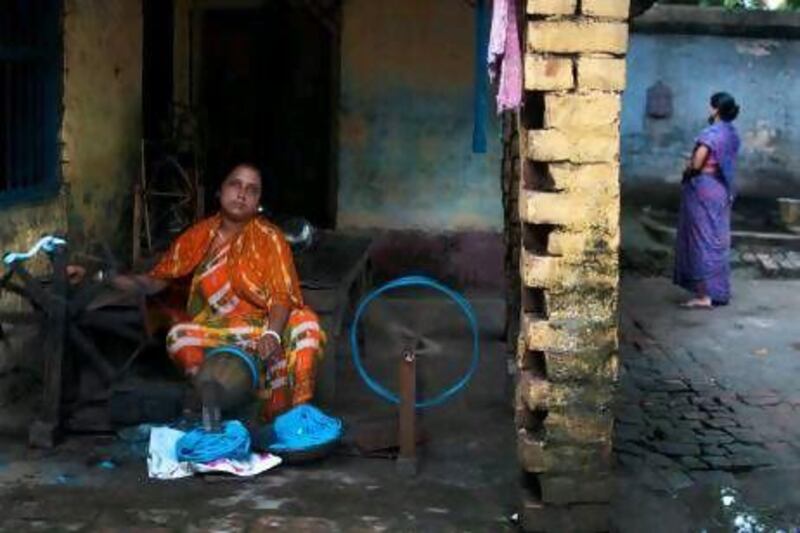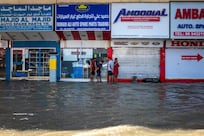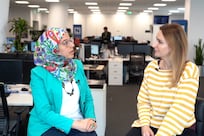"Careful with the acid," commands Shomarani Mondol from the ramshackle hut she calls her "factory". In a checked cotton sari, hunched down on her knees on the brick floor, the 45 year old checks the amount of sulphuric acid being mixed with dyes to complete the saris she makes.
With a monthly demand for about 500 saris in the Kolkata markets, Mondol is a busy woman. But it wasn't always like this; just a few years ago, she struggled to make enough money to cook even two meals a day for her husband and children. The difference in her life came about with just 3,800 rupees (Dh257).
Mondol was introduced to microloans, a type of lending designed to offer small amounts of money to people who have difficulty borrowing funds from normal banks, a practice prevalent in developing and poorer countries such as India. The funds are intended to start or expand a small business, enabling the borrower to make a living.
"I lead a 'relux' [relaxed] life now," she says when asked to describe her ascent from hopeless poverty.
Because of that small loan from a microfinance company called Bandhan, Mondol became eligible for a larger loan from a major bank. She now employs 15 people in Canning, about 70 kilometres outside of Kolkata. Though she cannot read or write, her youngest daughter is a graduate and the eldest one is now married and working in an office. Her husband used to farm but now helps her manage the business.
Microfinance companies target women in an effort to raise the standard of living among the impoverished. The traditional role of women keeps them busy at the household chores while the men toil in the fields and factories. But also traditionally, the men aren't very good with money, and very often their wages are squandered on liquor, gambling or bad investments.
In stark contrast, it has been found that when women earn the children are fed well and regularly sent to school. The standard of health and well-being of the family goes up. It is for this reason that the microfinance institutions (MFIs) focus largely on women borrowers.
Most poor people without a bank account have no option. Banks won't give them loans because they have nothing to mortgage. And those who do are uneducated or unwilling to cruise through the bank's complex paperwork and long procedures. According to a report by The World Bank (Measuring Financial Inclusion, The Global Findex Database) more than 2.5 billion people worldwide do not have a bank account.
MFIs started their operations in India about 25 years ago, wanting to bridge this gap. Their uncomplicated and quick ways soon found many takers and, today, more than 30 million Indians have a microloan, with more than 20m of those being women. Yet, Mondol belongs to a minority of model borrowers that have made a major improvement. Not everyone has become such a success.
In the last few years, charges of malfeasance and corruption have hit the industry. As the demand for loans grew, some companies started charging borrowers with higher interest rates, traumatising the very people they were supposed to help. The aggressive loan recovery policies had pushed the borrowers to their limits. A spate of suicides followed in the southern state of Andhra Pradesh, and grieving families were left in more misery than before.
Amid extensive media coverage, the Indian government began to closely monitor the sector. Last year, the Reserve Bank of India (RBI), the central banking institution of the country, capped the interest rate to 26 per cent for micro loans up to 50,000 rupees. Previously, some MFIs would charge as much as 36 per cent.
A bill on empowering RBI to fully monitor and regulate the sector is now being debated in parliament.
Still, the concern of paying up is constant. "My greatest worry was will I be able to pay up weekly," says Nomita Biswas, 32, a weaver of fine hand-woven clothes from Shantipur, a renowned textile hub some 75km north of Kolkata. But whenever she failed to pay, other borrowers in her village chipped in for her, and Biswas paid them back when she had the money. These women met weekly, making a support group of sorts for each other. While sharing their tales of happiness and hardships they also ended up exchanging their business knowledge and experiences.
"This 'group methodology' is one of our central approaches," explains Chandra Shekhar Ghosh, 52, the founder of Bandhan. He describes the hope and inspiration that these group interactions can foster. "'If she can, so can I', is how people feel in a group," Ghosh adds.
Hope, it is argued, is necessary for these programmes to be successful. Esther Duflo, the co-author of Poor Economics (a book on understanding poverty and methods of poverty reduction) thinks that initiatives such as MFIs work well when poor people get a sense of hope. The realisation that there is a way out gives them a rare sense of positivity, helping them take charge of their lives.
"At the same time, it is crucial to understand what people really want," says Ghosh. "The same model doesn't work for everyone."
Coming from a poor family of second generation migrants from Bangladesh, Ghosh has known hardships. His father had a small meat shop where he had to work since he was small. So, his understanding of poverty goes deeper than just his field experiences.
"There are poor people who are so helpless, so powerless that they have no means of paying back if given a loan," he says. So, Bandhan came up with a different model to help this section. "We did not give them money, we helped them build assets." The idea is to give these people a livelihood, be it a small shop or cattle, and get them to the point where they can sustainably make money and pay back a loan.
"Had it not been for Bandhan, probably I would be begging today," says Madhabi Tiwari. Her husband died while crossing railway tracks adjacent to the teeming Dokkhin Dari slum near Kolkata, and her son suffered grave injuries trying to save him. Her husband was a labourer in a leather factory and drank daily, and when he died Tiwari had no savings. She was in a desperate state with an ailing son to take care of when Bandhan's field workers identified her. They bought her vegetables and helped her open a vegetable stall in the slum market, free of charge. Now, the 54 year old earns around 3,800-5,000 rupees per month and can provide better food and care for her 18-year-old son. "I am better off than before," she says. "Now I can at least buy milk for my son."
With a realistic methodology and round-the-clock service by field workers who go home only at weekends, today Bandhan's beneficiaries number more than 3.8 million in 18 states and union territories.
But still, millions of poor slip through the cracks, partly because of the higher interest rates. Bandhan gets money from various banks at a 14 per cent rate of interest and lends it out at 22.9 per cent - one of the lowest rates in the market. Still, for many, it is a lot of money to pay. So, Bandhan is planning to form a bank and collect savings from common people. They feel this will sharply cut the rate of interest and let them reach many more in need.
Other experiments, too, are happening. "Crowd funding" - a new way of collecting loan money, from both philanthropists not looking for a reward and investors in it for equity or profit sharing - seems to have struck a chord with young Indians. Mayukh Choudhury, 29, one of the young founders of Milaap, a Bangalore-based MFI riding on this trend, thinks this is a "midpoint between charity and financial investments".
But reaching out to the poor is a complicated matter. Poverty is complex; it is not as simple as a lack of money. Poor living conditions and health, hunger and a shortage of drinking water come with it. Some MFIs have chosen to break down this big lump and concentrate on the specifics, such as water supply, education and skill building. Bandhan aims at a more rounded development model. It believes change can come when all of these other factors have been taken care of, and in a joint effort, the borrowers and Bandhan have opened up community schools where children are taught free of charge and health centres have been set up.
Bringing any change in a country like India with its billions of poor is a challenge for MFIs, but also a lucrative opportunity. How they make a merger between these two will shape the future of the industry. "This is the minefield of finance," warns Ghosh. "When you are not able to mark your way with ethics, disasters are waiting to happen."
Yet, no matter the challenges, lives of the poor in Canning, in Shantipur and in the slums of Kolkata are changing. More children are going to school, more people have found work. Many people now have indoor plumbing. Incidents of theft have gone down. And some have even found happiness.
"What I am doing is nice," says Mondol. "Now I am not very poor or very rich, but at least I don't have to wash utensils at some rich man's house. I am doing my own thing, and I am happy."





